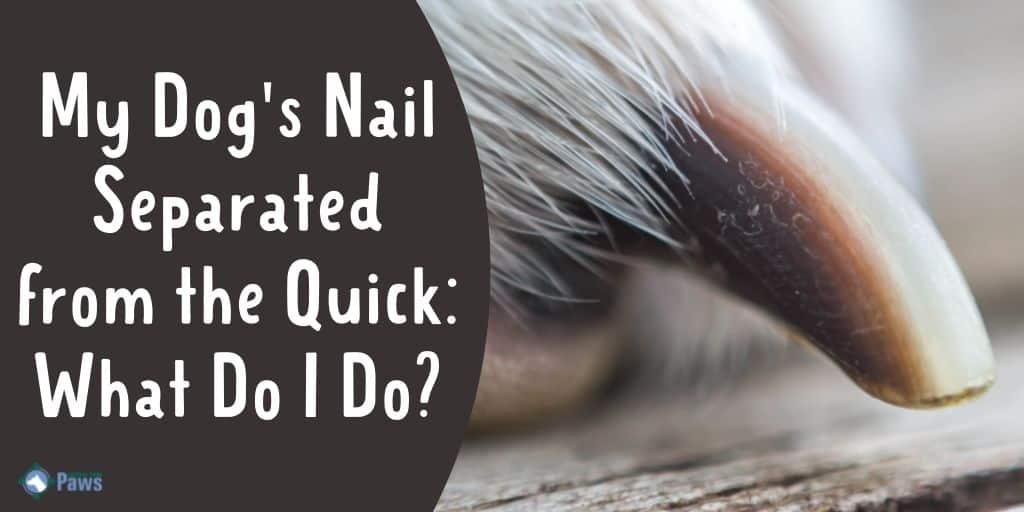I’m sure you’ve experienced the pain that comes with a broken nail, and this is something that dogs can experience too.
When your furry friends break their toenails, this can be very painful and uncomfortable for them.
Your dog might experience a cracked or broken nail due to injury or if they have brittle nails, which can especially be the case for older dogs.
There is usually a fair amount of bleeding in both circumstances, and a trip to the vet may be the best option to help treat the issue.
A dog nail separated from quick is also an extremely painful experience.
Knowing your canine pal is in pain is a horrible feeling for all pet owners.
To understand how to know whether your dog has injured its claws and the things you should do to treat it, keep reading!
The Structure of Your Dog’s Nails
Dog nails have hard surfaces, with the material on the outside being called the shell. The nail bed is known as the quick[1].
A dog’s nail quick contains living tissue with blood vessels, and this is responsible for supplying blood to the entire nail.
If these nerves get cut (such as through a nail injury), it gets extremely painful and causes bleeding.
When looked after and trimmed regularly, the quick recedes from the end of the nail, which protects it if the top part of the nail gets damaged.
Failure to cut a dog’s toenail regularly can lead to them having very long nails, making it difficult for them to walk correctly[2], increasing the risk of nail damage.
How to Spot a Broken Nail?
If your dog is limping, favoring one paw, licking the area, or if you spot bleeding, these can all be signs that your dog has damaged a claw[3].
When looking at your dog’s paw to further inspect the nail, you should be very gentle as the area will likely be very sore.
Types of Dog Nail Injuries
There are three main types of nail injuries that a dog may experience.
Firstly, there is the scenario where their claw completely breaks off and bleeds (learn how to stop your dog’s nail bleeding).
Secondly, they can have a cracked, broken, or torn nail where it is still loosely attached.
Thirdly, the claw might crack and break but remain firmly attached.
How to Treat Your Dog’s Nail?
Broken claws aren’t always a medical emergency, but it can be very painful for your dog, with bleeding and a high chance of infection.
In addition, your dog’s paw will be very sensitive, so when you go about treating or taking them to the vet, you need to be very gentle and careful when handling their paw.
While it might seem like a scary scenario, the better one is when the claw is completely broken and rips off.
There should only be minimal bleeding in this case, and this isn’t something to cause alarm.
The blood comes from the blood vessels quickly, and there is a simple way to stop it.
All you need to do is find a gauze or clean cloth and apply pressure until the bleeding stops.
Try to keep your pet nice and calm when you’re doing this. Don’t compress or apply too much pressure to their paw.
If the applied pressure doesn’t work and the bleeding continues, you can try using some styptic powder or baking soda.
Then, apply more pressure for further 5 minutes. It’s a good idea to keep some of this powder, or a styptic pencil, in your first aid kit if an emergency like this ever occurs.
If the nail still doesn’t stop bleeding, it is time to head to the ER.
What If the Nail Is Still Attached?
You should only try to remove your dog’s cracked, damaged nail yourself if it is very loosely attached.
If this is the case, then you need to safely restrain your pet and pull the nail with a quick motion.
You should do this with a sterile pet nail clipper to prevent infection.
If bleeding occurs after removing the nail, you can use the gauze method mentioned above.
Next, you should thoroughly clean the area with warm water and use pet antiseptic.
Finally, bandage up the area, although not too tight, and secure it with first aid tape.
Keep the bandage on until the wound heals to protect the area from infection.
If the nail is cracked and still firmly attached, then you should not attempt to remove this at home.
This is where you should seek veterinary care, especially when there is continuous bleeding.
In either scenario, the split nail must be removed to allow the new nail to grow and heal.
When treated by a vet, they may use a topical anesthetic to help ease the pain as removing the nail can be painful, albeit very quick.
When to Take Your Dog to the Vet?
When it comes to your dog’s broken nails, there are some scenarios where you should take them to the vet.
As mentioned earlier, if you can’t stop the bleeding, you should go to the vet immediately to prevent your pet from losing too much blood.
You should also take them to the vet if you think there is a possible infection.
The signs of this would be limping, continuous bleeding, or if your dog appears to bite or lick its claws continuously.
When a vet treats a broken nail, they will usually use pain medication and prescribe antibiotics to provide pain relief and help lower the chances of infection.
How to Spot Infection?
It’s essential to monitor your dogs’ claws to ensure they don’t get infected or recognize when it does.
The nail is likely infected if your dog has labored breathing, dark nails, or if its nail is a reddish-brown color.
If you spot these signs and think your dog has picked up an infection, you should go to the vet as soon as possible.
How Long Will it Take to Heal?
After treatment is given to torn nails, whether at home or at a veterinary clinic, it should only take a few days for the pain and swelling to subside.
While it is healing, it is okay if your dog licks the area as this is a natural way they keep it clean and help reduce the need for antibiotics.
However, especially with puppies, they can sometimes go overboard and irritate the area, making the pain worse.
The signs of this include redness, swelling, and discharge.
If you are worried that your dog might do this, then the good idea is to get an Elizabethan collar for them.
They might look a little funny, but it will be completely worth it.




